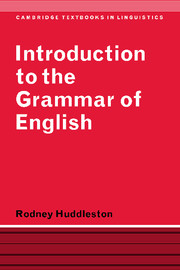Book contents
- Frontmatter
- Contents
- Preface
- Table of symbols and notational conventions
- 1 Basic concepts in grammar
- 2 The structural approach to linguistic analysis
- 3 The parts of speech
- 4 Verbs and verb phrases
- 5 The structure of kernel clauses
- 6 Nouns and noun phrases
- 7 Pronouns
- 8 Adjectives and adjective phrases
- 9 Verbs, nouns and adjectives: the boundaries between them
- 10 Adverbs, prepositions and conjunctions
- 11 Clause type
- 12 Coordination and subordination
- 13 Negation
- 14 Thematic systems of the clause
- References
- Index
9 - Verbs, nouns and adjectives: the boundaries between them
Published online by Cambridge University Press: 05 June 2012
- Frontmatter
- Contents
- Preface
- Table of symbols and notational conventions
- 1 Basic concepts in grammar
- 2 The structural approach to linguistic analysis
- 3 The parts of speech
- 4 Verbs and verb phrases
- 5 The structure of kernel clauses
- 6 Nouns and noun phrases
- 7 Pronouns
- 8 Adjectives and adjective phrases
- 9 Verbs, nouns and adjectives: the boundaries between them
- 10 Adverbs, prepositions and conjunctions
- 11 Clause type
- 12 Coordination and subordination
- 13 Negation
- 14 Thematic systems of the clause
- References
- Index
Summary
In Chs. 4, 6 and 8 we have set out the grammatical properties which characterise the three major parts of speech – and it is clear that in a sentence like Both men became very angry, for example, we can distinguish very sharply between the verb became, the noun men and the adjective angry. Non-central members, however, are often significantly less easily distinguishable: the frequent appearance in grammars of expressions like ‘verbal noun’, ‘noun used as an adjective’, and so on, attests to this. In the present chapter I will consider in turn each of the pairs verb/noun, verb/adjective and noun/adjective, partly in order to develop and sharpen the earlier account of the distinctive properties of the classes, partly in order to draw attention to certain problems that arise in drawing boundaries between them or between the associated phrase classes.
We noted in 2.4 that what we are calling -ing forms of verbs are traditionally analysed as either gerunds (as in Taking [exams was a waste of time]) or present participles (as in [Everyone] taking [the coach should report here at 6 a.m.]). We argued against making any inflectional distinction between them on the grounds that no verb in the language exhibits any morphological contrast here. The traditional concepts are worth taking up again at this point, however, because they also cover words that we do not regard as -ing forms of verbs.
- Type
- Chapter
- Information
- Introduction to the Grammar of English , pp. 312 - 329Publisher: Cambridge University PressPrint publication year: 1984



